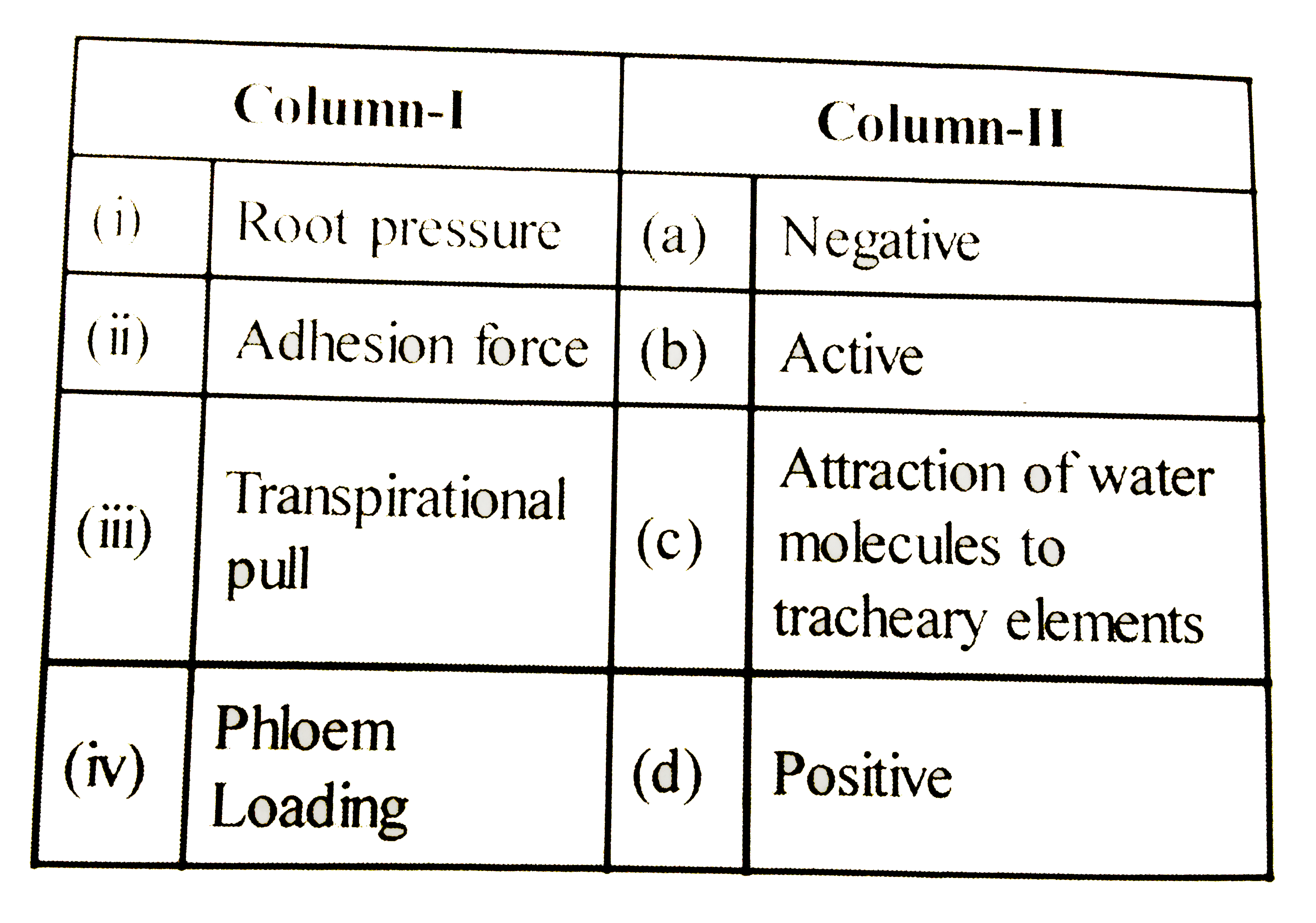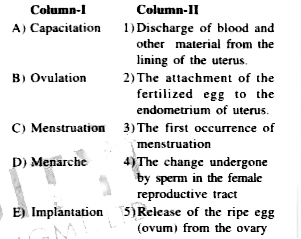Match the animals listed under Column-I with the excretory organs given under Column - II and select the correct option .
Column−I(Animals)Column−II(Excretory organs)(a)Fasciola(i)Nephridia(b)Hirudinaria(ii)malpighian tubules(c)Balanoglossus(iii)Protonephridia(d)Laccifer(iv)Proboscis gland
1)(a)(b)(c)(d)(iii)(i)(ii)(iv)
2)(a)(b)(c)(d)(i)(iii)(iv)(ii)
3)(a)(b)(c)(d)(i)(iii)(ii)(iv)
4)(a)(b)(c)(d)(iii)(iv)(i)(ii)
The correct Answer is:A
To solve the question of matching animals with their respective excretory organs, we will analyze each animal listed in Column-I and identify the correct excretory organ from Column-II.
1. Identify the excretory organ for Fasciola:
- Fasciola, commonly known as the liver fluke, has an excretory system that includes protonephridia.
- Match: A (Fasciola) → iii (Protonephridia)
2. Identify the excretory organ for Hirudinaria:
- Hirudinaria, known as the medicinal leech, possesses nephridia as its excretory organ.
- Match: B (Hirudinaria) → i (Nephridia)
3. Identify the excretory organ for Balanoglossus:
- Balanoglossus, a member of the phylum Hemichordata, has a proboscis gland as its excretory organ.
- Match: C (Balanoglossus) → iv (Proboscis gland)
4. Identify the excretory organ for Laccifer:
- Laccifer, a type of lac insect, belongs to the phylum Arthropoda and has Malpighian tubules for excretion.
- Match: D (Laccifer) → ii (Malpighian tubules)
Summary of Matches:
- A → iii (Fasciola → Protonephridia)
- B → i (Hirudinaria → Nephridia)
- C → iv (Balanoglossus → Proboscis gland)
- D → ii (Laccifer → Malpighian tubules)
Final Matching:
- A (Fasciola) → iii (Protonephridia)
- B (Hirudinaria) → i (Nephridia)
- C (Balanoglossus) → iv (Proboscis gland)
- D (Laccifer) → ii (Malpighian tubules)
Correct Option:
Based on the matches, the correct option is 3, 1, 4, 2.
- Fasciola, commonly known as the liver fluke, has an excretory system that includes protonephridia.
- Match: A (Fasciola) → iii (Protonephridia)
- Hirudinaria, known as the medicinal leech, possesses nephridia as its excretory organ.
- Match: B (Hirudinaria) → i (Nephridia)
- Balanoglossus, a member of the phylum Hemichordata, has a proboscis gland as its excretory organ.
- Match: C (Balanoglossus) → iv (Proboscis gland)
- Laccifer, a type of lac insect, belongs to the phylum Arthropoda and has Malpighian tubules for excretion.
- Match: D (Laccifer) → ii (Malpighian tubules)
- A → iii (Fasciola → Protonephridia)
- B → i (Hirudinaria → Nephridia)
- C → iv (Balanoglossus → Proboscis gland)
- D → ii (Laccifer → Malpighian tubules)
- A (Fasciola) → iii (Protonephridia)
- B (Hirudinaria) → i (Nephridia)
- C (Balanoglossus) → iv (Proboscis gland)
- D (Laccifer) → ii (Malpighian tubules)
Based on the matches, the correct option is 3, 1, 4, 2.
Topper's Solved these Questions
- ANIMAL KINGDOM BOOK - AAKASH SERIESCHAPTER - ANIMAL KINGDOM EXERCISE - EXERCISE -III (Previous AIPMT/NEET Questions)
35 Videos
- ANIMAL KINGDOM BOOK - AAKASH SERIESCHAPTER - ANIMAL KINGDOM EXERCISE - EXERCISE -II (MAMMALIA)
21 Videos
- BIODIVERSITY AND CONSERVATIONBOOK - AAKASH SERIESCHAPTER - BIODIVERSITY AND CONSERVATIONEXERCISE - EXERCISE-II India - A major Source of Biodiversity and its Preservation
2 Videos
Similar Questions
Match column I with column II and select the correct option.

View SolutionMatch column I with column II and select the correct option.

View SolutionMatch the terms column-I with their functions in column-II and select the correct option

View SolutionMatch the terms column-I with their functions in column-II and select the correct option

View SolutionMatch the column-I with column -II and select the correct option :

View SolutionMatch the column-I with column-II and select the correct option :

View SolutionMatch the column I with column II and select the correct option

View SolutionMatch column -I with column-II and select the correct option :-

View SolutionMatch the excretory organs listed under column I with the animals given under column II and select the correct option.
ColumnIColumnII(Excretory organs)(Animals)A.Nephridia(i)HydraB.Malpighian tubules(ii)LeechC.Protonephridia(iii)SharkD.Kidneys(iv)Roundworms(v)Cockroach
View SolutionMatch the terms column-I with column-II and select the correct option

View Solution
